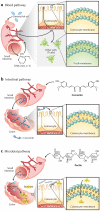Nutrient-Gene Interaction in Colon Cancer, from the Membrane to Cellular Physiology
- PMID: 27431370
- PMCID: PMC5034935
- DOI: 10.1146/annurev-nutr-071715-051039
Nutrient-Gene Interaction in Colon Cancer, from the Membrane to Cellular Physiology
Abstract
The International Agency for Research on Cancer recently released an assessment classifying red and processed meat as "carcinogenic to humans" on the basis of the positive association between increased consumption and risk for colorectal cancer. Diet, however, can also decrease the risk for colorectal cancer and be used as a chemopreventive strategy. Bioactive dietary molecules, such as n-3 polyunsaturated fatty acids, curcumin, and fermentable fiber, have been proposed to exert chemoprotective effects, and their molecular mechanisms have been the focus of research in the dietary/chemoprevention field. Using these bioactives as examples, this review surveys the proposed mechanisms by which they exert their effects, from the nucleus to the cellular membrane. In addition, we discuss emerging technologies involving the culturing of colonic organoids to study the physiological effects of dietary bioactives. Finally, we address future challenges to the field regarding the identification of additional molecular mechanisms and other bioactive dietary molecules that can be utilized in our fight to reduce the incidence of colorectal cancer.
Keywords: colonic organoids; membrane organization; microRNAs; n-3 polyunsaturated fatty acids.
Figures





Similar articles
-
Analysis of the Anti-Cancer Effects of Cincau Extract (Premna oblongifolia Merr) and Other Types of Non-Digestible Fibre Using Faecal Fermentation Supernatants and Caco-2 Cells as a Model of the Human Colon.Nutrients. 2017 Apr 3;9(4):355. doi: 10.3390/nu9040355. Nutrients. 2017. PMID: 28368356 Free PMC article.
-
Membrane lipid raft organization is uniquely modified by n-3 polyunsaturated fatty acids.Prostaglandins Leukot Essent Fatty Acids. 2013 Jan;88(1):43-7. doi: 10.1016/j.plefa.2012.03.008. Epub 2012 Apr 18. Prostaglandins Leukot Essent Fatty Acids. 2013. PMID: 22515942 Free PMC article. Review.
-
Genetic reprogramming in pathways of colonic cell maturation induced by short chain fatty acids: comparison with trichostatin A, sulindac, and curcumin and implications for chemoprevention of colon cancer.Cancer Res. 2000 Aug 15;60(16):4561-72. Cancer Res. 2000. PMID: 10969808
-
Dietary walnut suppression of colorectal cancer in mice: Mediation by miRNA patterns and fatty acid incorporation.J Nutr Biochem. 2015 Jul;26(7):776-83. doi: 10.1016/j.jnutbio.2015.02.009. Epub 2015 Apr 1. J Nutr Biochem. 2015. PMID: 25882694
-
Diet and Gut Microbes Act Coordinately to Enhance Programmed Cell Death and Reduce Colorectal Cancer Risk.Dig Dis Sci. 2020 Mar;65(3):840-851. doi: 10.1007/s10620-020-06106-8. Dig Dis Sci. 2020. PMID: 32006211 Free PMC article. Review.
Cited by
-
Fish Consumption and Colorectal Cancer Risk: Meta-Analysis of Prospective Epidemiological Studies and Review of Evidence from Animal Studies.Cancers (Basel). 2022 Jan 27;14(3):640. doi: 10.3390/cancers14030640. Cancers (Basel). 2022. PMID: 35158907 Free PMC article. Review.
-
Expression of GOLPH3 protein in colon cancer tissues and its association with the prognosis of patients.Oncol Lett. 2016 Nov;12(5):3936-3940. doi: 10.3892/ol.2016.5215. Epub 2016 Sep 29. Oncol Lett. 2016. PMID: 27895752 Free PMC article.
-
A Screening of Native (Poly)phenols and Gut-Related Metabolites on 3D HCT116 Spheroids Reveals Gut Health Benefits of a Flavan-3-ol Metabolite.Mol Nutr Food Res. 2022 Nov;66(21):e2101043. doi: 10.1002/mnfr.202101043. Epub 2022 Apr 26. Mol Nutr Food Res. 2022. PMID: 35394679 Free PMC article.
-
The Impact of Diet on the Involvement of Non-Coding RNAs, Extracellular Vesicles, and Gut Microbiome-Virome in Colorectal Cancer Initiation and Progression.Front Oncol. 2020 Dec 14;10:583372. doi: 10.3389/fonc.2020.583372. eCollection 2020. Front Oncol. 2020. PMID: 33381452 Free PMC article. Review.
-
Nutrigenomics and microbiome shaping the future of personalized medicine: a review article.J Genet Eng Biotechnol. 2023 Nov 22;21(1):134. doi: 10.1186/s43141-023-00599-2. J Genet Eng Biotechnol. 2023. PMID: 37993702 Free PMC article. Review.
References
-
- Abdelrahim M, Baker CH, Abbruzzese JL, Sheikh-Hamad D, Liu S, et al. Regulation of vascular endothelial growth factor receptor-1 expression by specificity proteins 1, 3, and 4 in pancreatic cancer cells. Cancer Res. 2007;67:3286–94. - PubMed
-
- Aggarwal BB, Shishodia S. Molecular targets of dietary agents for prevention and therapy of cancer. Biochem. Pharmacol. 2006;71:1397–421. - PubMed
-
- Amaral CL, Crisma AR, Masi LN, Martins AR, Hirabara SM, Curi R. DNA methylation changes induced by a high-fat diet and fish oil supplementation in the skeletal muscle of mice. J. Nutrigenet. Nutrigenom. 2014;7:314–26. - PubMed
Publication types
MeSH terms
Substances
Grants and funding
LinkOut - more resources
Full Text Sources
Other Literature Sources

